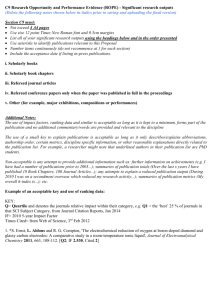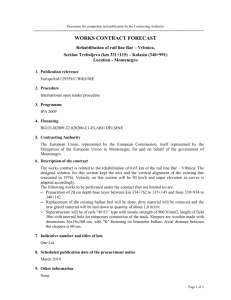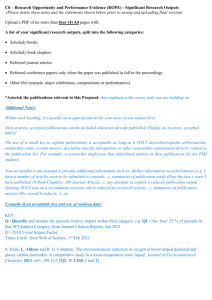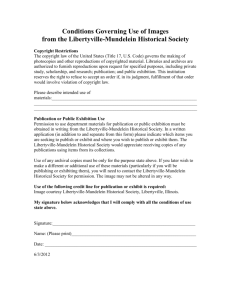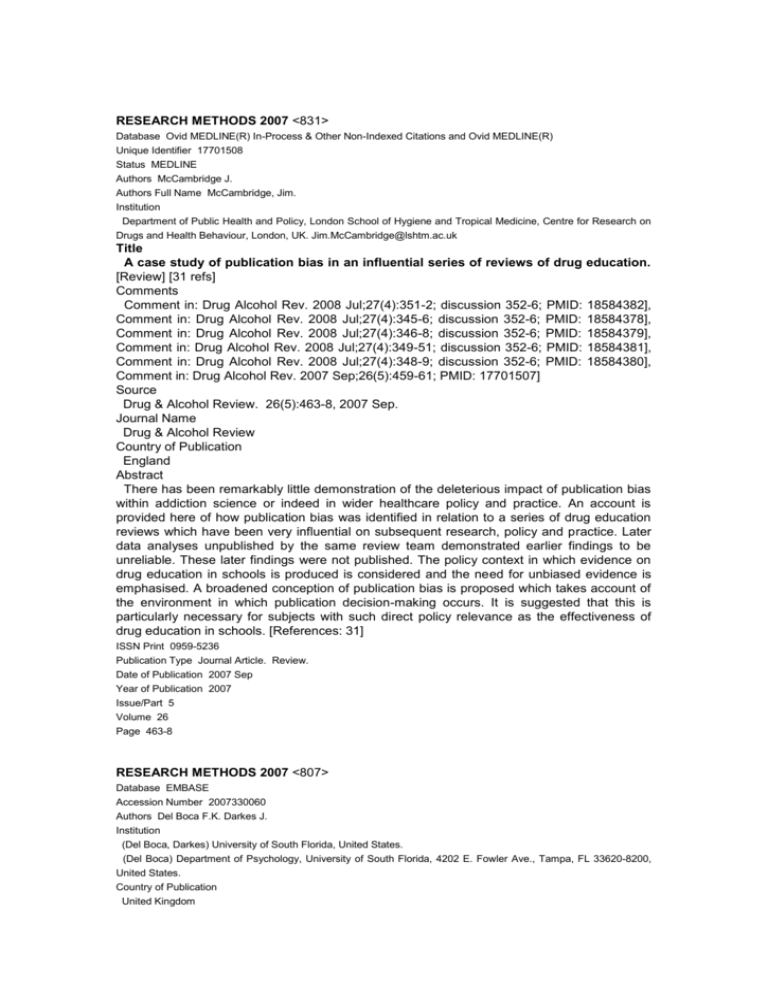
RESEARCH METHODS 2007 <831>
Database Ovid MEDLINE(R) In-Process & Other Non-Indexed Citations and Ovid MEDLINE(R)
Unique Identifier 17701508
Status MEDLINE
Authors McCambridge J.
Authors Full Name McCambridge, Jim.
Institution
Department of Public Health and Policy, London School of Hygiene and Tropical Medicine, Centre for Research on
Drugs and Health Behaviour, London, UK. Jim.McCambridge@lshtm.ac.uk
Title
A case study of publication bias in an influential series of reviews of drug education.
[Review] [31 refs]
Comments
Comment in: Drug Alcohol Rev. 2008 Jul;27(4):351-2; discussion 352-6; PMID: 18584382],
Comment in: Drug Alcohol Rev. 2008 Jul;27(4):345-6; discussion 352-6; PMID: 18584378],
Comment in: Drug Alcohol Rev. 2008 Jul;27(4):346-8; discussion 352-6; PMID: 18584379],
Comment in: Drug Alcohol Rev. 2008 Jul;27(4):349-51; discussion 352-6; PMID: 18584381],
Comment in: Drug Alcohol Rev. 2008 Jul;27(4):348-9; discussion 352-6; PMID: 18584380],
Comment in: Drug Alcohol Rev. 2007 Sep;26(5):459-61; PMID: 17701507]
Source
Drug & Alcohol Review. 26(5):463-8, 2007 Sep.
Journal Name
Drug & Alcohol Review
Country of Publication
England
Abstract
There has been remarkably little demonstration of the deleterious impact of publication bias
within addiction science or indeed in wider healthcare policy and practice. An account is
provided here of how publication bias was identified in relation to a series of drug education
reviews which have been very influential on subsequent research, policy and practice. Later
data analyses unpublished by the same review team demonstrated earlier findings to be
unreliable. These later findings were not published. The policy context in which evidence on
drug education in schools is produced is considered and the need for unbiased evidence is
emphasised. A broadened conception of publication bias is proposed which takes account of
the environment in which publication decision-making occurs. It is suggested that this is
particularly necessary for subjects with such direct policy relevance as the effectiveness of
drug education in schools. [References: 31]
ISSN Print 0959-5236
Publication Type Journal Article. Review.
Date of Publication 2007 Sep
Year of Publication 2007
Issue/Part 5
Volume 26
Page 463-8
RESEARCH METHODS 2007 <807>
Database EMBASE
Accession Number 2007330060
Authors Del Boca F.K. Darkes J.
Institution
(Del Boca, Darkes) University of South Florida, United States.
(Del Boca) Department of Psychology, University of South Florida, 4202 E. Fowler Ave., Tampa, FL 33620-8200,
United States.
Country of Publication
United Kingdom
Title
Enhancing the validity and utility of randomized clinical trials in addictions treatment
research: II. Participant samples and assessment.
Source
Addiction. 102(8)(pp 1194-1203), 2007. Date of Publication: Aug 2007.
Abstract
Purpose: This paper is the second in a series that describes strategies for optimizing the
validity and utility of randomized clinical trials (RCTs) in addictions treatment research.
Whereas the first paper focused on treatment implementation and research design, here we
address issues pertaining to participant samples and assessment methods. Scope: With
respect to participant samples, sections focus on the definition of study populations; informed
consent; sample size and statistical power; recruitment and enrollment; sample retention; and
participant tracking systems. Assessment topics include eligibility screening and baseline
assessment; treatment-related variables; outcome measures; the frequency of follow-up
evaluation; and assessment process. A final section highlights the importance of pilot testing.
Conclusions: Sample recruitment and retention strategies are needed that safeguard both
internal and external validity. Daily estimation assessment procedures are recommended
because of their versatility for creating a range of outcome measures. Assessment batteries
should include measures that permit the investigation of treatment processes and
mechanisms of action. copyright 2007 The Authors.
ISSN 0965-2140
Publication Type Journal: Article
Journal Name Addiction
Volume 102
Issue Part 8
Page 1194-1203
Year of Publication 2007
Date of Publication Aug 2007
RESEARCH METHODS 2007 <809>
Database EMBASE
Accession Number 2007290373
Authors Del Boca F.K. Darkes J.
Institution
(Del Boca, Darkes) University of South Florida, United States.
(Del Boca) Department of Psychology, University of South Florida, 4202 E. Fowler Ave., Tampa, FL 33620-8200,
United States.
Country of Publication
United Kingdom
Title
Enhancing the validity and utility of randomized clinical trials in addictions treatment
research: I. Treatment implementation and research design.
Source
Addiction. 102(7)(pp 1047-1056), 2007. Date of Publication: Jul 2007.
Abstract
Purpose: This paper is the first in a series that examines methods for improving the validity
and utility of randomized clinical trials (RCTs) in addictions treatment research. The specific
foci of this article are treatment implementation and research design. Scope: We begin by
considering the conditions under which the RCT provides an appropriate design choice.
Sections that follow discuss methodological issues with respect to RCT structure and
collaborative arrangements; treatment specification, delivery and cost; experimental design;
and randomization/blinding procedures. We emphasize the importance of advance planning;
treatment integrity and discriminability; treatment standardization; staff training and
supervision; client compliance; maintenance of between-group equivalence across study
conditions; and inclusion of appropriate comparison groups in study designs. Conclusions:
Investigators are encouraged to maximize the internal validity of RCTs, but also to consider
methods for enhancing external validity. The utility of addictions RCTs for advancing theory
and improving clinical practice can be enhanced by investigating underlying mechanisms of
action. copyright 2007 The Authors.
ISSN 0965-2140
Publication Type Journal: Review
Journal Name Addiction
Volume 102
Issue Part 7
Page 1047-1056
Year of Publication 2007
Date of Publication Jul 2007
RESEARCH METHODS 2007 <823>
Database EMBASE
Accession Number 2006614843
Authors Patak M. Reynolds B.
Institution
(Patak, Reynolds) Columbus Children's Research Institute, Department of Pediatrics, The Ohio State University,
700 Children's Drive, J1401, Columbus, OH 43205, United States.
Country of Publication
United Kingdom
Title
Question-based assessments of delay discounting: Do respondents spontaneously
incorporate uncertainty into their valuations for delayed rewards?
Source
Addictive Behaviors. 32(2)(pp 351-357), 2007. Date of Publication: Feb 2007.
Abstract
This research was designed to determine if, and to what extent, participants incorporate
uncertainty into their valuations for delayed rewards when completing measures of delay
discounting, even though uncertainty is not specified in the delay-discounting questions.
Twenty-four adolescent participants completed a question-based measure of delay
discounting and immediately following answered questions about perceived certainties of
receiving the delayed rewards. Results showed that respondents rated the delayed rewards
as increasingly uncertain with longer delays. Also, ratings of uncertainty were correlated with
rate of delay discounting (r = 0.55). These findings suggest participants automatically
evaluate delayed rewards as uncertain when using this assessment procedure. The current
finding may hold important implications for future addiction research in interpreting why
addicted persons often discount more by delay than non-addicted controls, i.e., delay to
reward or uncertainty about delayed rewards? copyright 2006 Elsevier Ltd. All rights reserved.
ISSN 0306-4603
Publication Type Journal: Article
Journal Name Addictive Behaviors
Volume 32
Issue Part 2
Page 351-357
Year of Publication 2007
Date of Publication Feb 2007
RESEARCH METHODS 2007 <897>
Database EMBASE
Accession Number 2007526452
Authors Albert P.S. Follmann D.A.
Institution
(Albert) Biometric Research Branch, Division of Cancer Treatment and Diagnosis, National Cancer Institute,
(Follmann) Biostatistics Research Branch, National Institute of Allergy and Infectious Disease,
Country of Publication
United Kingdom
Title
Random effects and latent processes approaches for analyzing binary longitudinal
data with missingness: A comparison of approaches using opiate clinical trial data.
Source
Statistical Methods in Medical Research. 16(5)(pp 417-439), 2007. Date of Publication: Oct
2007.
Abstract
The analysis of longitudinal data with non-ignorable missingness remains an active area in
biostatistics research. This article discusses various random effects and latent process
models which have been proposed for analyzing longitudinal binary data subject to both nonignorable intermittent missing data and dropout. These models account for non-ignorable
missingness by introducing random effects or a latent process which is shared between the
response model and the model for the missing-data mechanism. We discuss various random
effects and latent processes approaches and compare these approaches with analyses from
an opiate clinical trial data set, which had high proportion of intermittent missingness and
dropout. We also compare these random effect and latent process approaches with other
methods for accounting for non-ignorable missingness using this data set. copyright 2007
SAGE Publications Los Angeles, London, New Delhi and Singapore.
ISSN 0962-2802
Publication Type Journal: Article
Journal Name Statistical Methods in Medical Research
Volume 16
Issue Part 5
Page 417-439
Year of Publication 2007
Date of Publication Oct 2007
RESEARCH METHODS 2007 <971>
Database EMBASE
Accession Number 2007460343
Authors Tonigan J.S.
Institution
(Tonigan) Center on Alcoholism, Substance Abuse and Addictions, University of New Mexico, Department of
Psychology, Albuquerque, NM, United States.
(Tonigan) 2350 Alamo S.E., Albuquerque, NM 87131, United States.
Country of Publication
United Kingdom
Title
Statistical considerations in identifying mechanisms of change.
Source
Alcoholism: Clinical and Experimental Research. 31(SUPPL. 3)(pp 55S-56S), 2007. Date of
Publication: Oct 2007.
Abstract
The statistical search for mechanisms of change involves multiple inferential tests, ones that
generally follow a fixed sequence designed to demonstrate mediation. While there are several
popular approaches to conducting such tests, e.g., SEM and MRA, the inflated Type I error
rate problem associated with conducting these tests has received little, if any, attention. This
paper offers 2 solutions to avoid committing Type I errors associated with mediational tests.
Most straightforward, investigators may choose to use a Bonferroni adjustment. In contrast, a
design-based approach can be used that tests rival explanations for the observed effects.
Examples drawn from addiction research are provided. copyright 2007 by the Research
Society on Alcoholism.
ISSN 0145-6008
Publication Type Journal: Article
Journal Name Alcoholism: Clinical and Experimental Research
Volume 31
Issue Part SUPPL. 3
Page 55S-56S
Year of Publication 2007
Date of Publication Oct 2007
RESEARCH METHODS 2007 <995>
Database EMBASE
Accession Number 2007425336
Authors Messinis L. Kosmidis M.H. Tsakona I. Georgiou V. Aretouli E. Papathanasopoulos P.
Institution
(Messinis, Tsakona, Papathanasopoulos) Department of Neurology, Neuropsychology Unit, University of Patras
Medical School, Rion, Patras, Greece.
(Kosmidis, Aretouli) Department of Psychology, Aristotle University of Thessaloniki, Greece.
(Georgiou) Departments of Mathematics and Statistics, University of Patras, Greece.
Country of Publication
United Kingdom
Title
Ruff 2 and 7 Selective Attention Test: Normative data, discriminant validity and testretest reliability in Greek adults.
Source
Archives of Clinical Neuropsychology. 22(6)(pp 773-785), 2007. Date of Publication: Aug
2007.
Abstract
Rapidly expanding interest in neuropsychological assessment in Greece has made the
development of appropriate culture-specific normative data for core neuropsychological
measures essential. In the present study, we sought to establish normative, test-retest
reliability and discriminant validity data for the Ruff 2 and 7 Selective Attention Test in the
Greek adult population. We administered the test using standard procedures to 218 healthy
Greek adults (95 men), aged 17-80 years and two adult patient groups (26 detoxified opiate
addicts and 23 HIV seropositive individuals). Using linear regression analyses, we examined
the contribution of age, education and gender on Ruff 2 and 7 performance. We further
examined test-retest reliability by administering the test on two occasions to 40 healthy adults,
with an intersession interval of 12-14 weeks. The regression analyses revealed that age and
education, but not gender, contributed significantly to participants performance, with older age
and lower education contributing to poorer performance on Speed scores, but only education
contributing moderately to Automatic Detection Accuracy scores. Test-retest reliability was
very high (.94-.98) for Speed scores, and adequate to high (.73-.89) for Accuracy scores.
Younger adults also demonstrated larger practice effects compared to older participants. The
test appears to discriminate adequately between the performance of detoxified opiate addicts
and HIV seropositive patients and matched healthy controls, as both patient groups
performed more poorly than their respective control group. We present normative data for
Speed and Accuracy scores stratified by age and education for the Greek adult population.
copyright 2007 National Academy of Neuropsychology.
ISSN 0887-6177
Publication Type Journal: Article
Journal Name Archives of Clinical Neuropsychology
Volume 22
Issue Part 6
Page 773-785
Year of Publication 2007
Date of Publication Aug 2007
RESEARCH METHODS 2007 <295>
Database EMBASE
Accession Number 2007157819
Authors Mold A.
Institution
(Mold) Centre for History in Public Health, Department of Public Health and Policy, London School of Hygiene and
Tropical Medicine, Keppel Street, London WC1E 7HT, United Kingdom.
Country of Publication
United Kingdom
Title
Illicit drugs and the rise of epidemiology during the 1960s.
Source
Journal of Epidemiology and Community Health. 61(4)(pp 278-281), 2007. Date of
Publication: Apr 2007.
Abstract
Epidemiology has been crucial to the understanding of both tobacco smoking and illicit drug
taking as public health issues in Britain since the 1960s. There were, however, significant
differences in the way in which epidemiology was used between the two psychoactive
substances.
ISSN 0143-005X
Publication Type Journal: Review
Journal Name Journal of Epidemiology and Community Health
Volume 61
Issue Part 4
Page 278-281
Year of Publication 2007
Date of Publication Apr 2007
HEALTH AND SOCIAL / RESEARCH METHODS 2007 <371>
Database EMBASE
Accession Number 2007000202
Authors Day E. Best D.
Institution
(Day, Best) University of Birmingham, United Kingdom.
(Day, Best) University of Birmingham, United Kingdom.
Country of Publication
United Kingdom
Title
Natural history of substance-related problems.
Source
Psychiatry. 6(1)(pp 12-15), 2007. Date of Publication: Jan 2007.
Abstract
The natural history of substance-related problems is technically challenging to study, and
data comes from a combination of point prevalence and long-term outcome studies of
treatment populations. Use of both alcohol and drugs is highest in people in their early 20s,
although the majority cut down their use as adult responsibilities take hold. Addicts with a
progressive course either continue to abuse substances despite a worsening of their
problems, or they become stably abstinent, usually in response to the very severity of their
addiction. The mortality rate of people dependent on alcohol or drugs is much higher than the
non-addict population. The study of 'natural recovery' or self-change has provided new
insights into the process of recovery from addiction, and it is likely that treatment plays only a
minor part in this process. Factors relating to both the characteristics of the substance and the
context of its use influence both the proportion of people who will become dependent on it
and the longevity of their addiction careers. copyright 2006 Elsevier Ltd. All rights reserved.
ISSN 1476-1793
Publication Type Journal: Review
Journal Name Psychiatry
Volume 6
Issue Part 1
Page 12-15
Year of Publication 2007
Date of Publication Jan 2007




